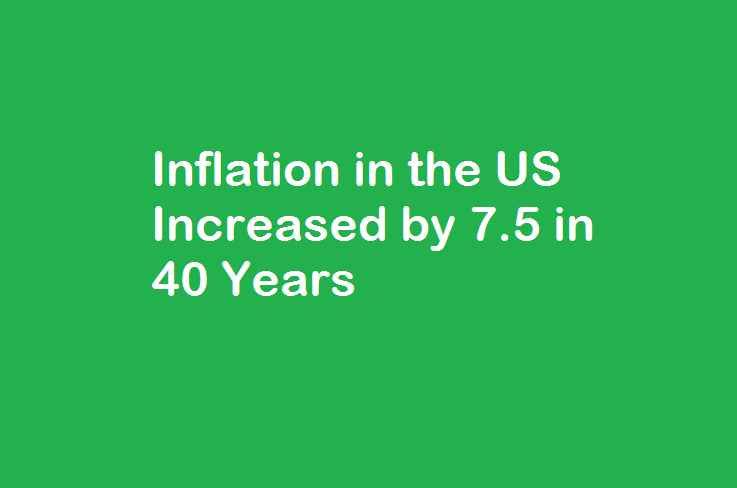According to a recent report released by Forbes Advisor News, inflation in the United States has increased by 7.5% over the past 40 years.
The report, which analyzed inflation rates from 1981 to 2021, reveals that the cost of living in the US has steadily risen over the past four decades. In 1981, the Consumer Price Index (CPI) was at 88.5, while in 2021 it climbed up to 189.7. This indicates an increase of 7.5% in inflation over the 40-year period.
Inflation is measured as the rate at which the general price level of goods and services in an economy increases over time. Factors such as changes in monetary policies, supply and demand for goods and services, and global economic conditions can all contribute to fluctuations in inflation rates.
While some economists believe that a moderate level of inflation is healthy for an economy, high inflation rates can lead to decreased purchasing power for consumers and can make it more difficult for businesses to plan and invest for the future.
Federal Reserve Response to Inflation
The Federal Reserve, also known as the Fed, is responsible for managing monetary policy in the United States and plays a key role in responding to inflation.
One of the primary tools the Fed uses to control inflation is the manipulation of interest rates. When inflation is high, the Fed may raise interest rates to encourage saving and discourage borrowing, which can help slow down the economy and reduce inflationary pressure. Conversely, when inflation is low, the Fed may lower interest rates to encourage borrowing and spending, which can stimulate economic growth and prevent deflation.
The Fed also monitors various economic indicators such as unemployment rates, wage growth, and consumer spending to determine the overall health of the economy and make decisions about monetary policy. Additionally, the Fed engages in open market operations, such as buying or selling government securities, to influence the supply of money in the economy.
Impact of Inflation on the US Economy
Inflation can have a significant impact on the US economy, affecting everything from consumer purchasing power to business investment and economic growth.
One of the main effects of inflation is the decrease in the purchasing power of money. In other words, as prices increase, the same amount of money can buy fewer goods and services. This can lead to reduced consumer spending, which can slow down economic growth and reduce business profits. Additionally, inflation can increase the cost of borrowing money, making it more expensive for businesses to invest and expand.
Another potential impact of inflation is that it can cause instability in financial markets, leading to increased volatility and risk. Inflation can also lead to wage increases as workers demand higher salaries to keep up with rising prices. However, if wages don’t keep pace with inflation, workers may experience a decline in their standard of living.
Furthermore, inflation can affect different groups in society differently. For example, those on fixed incomes, such as retirees, may be particularly vulnerable to the effects of inflation.
Historical Inflation in the US
Historical inflation in the US has varied widely over time, with periods of high and low inflation rates.
One of the most notable periods of high inflation in US history was during the 1970s and early 1980s. Inflation rates during this period were fueled by a combination of factors, including rising oil prices, increased government spending, and wage increases.
For example, in 1979, inflation reached a peak rate of 13.3%. To combat this high inflation, the Federal Reserve raised interest rates significantly, which had a negative impact on economic growth but helped to bring inflation under control.
In the 1990s and early 2000s, inflation rates remained relatively stable, with rates ranging from 1-4%. However, following the global financial crisis of 2008, inflation rates dropped to near-zero levels as the economy struggled to recover from the recession.
More recently, inflation has picked up again, with rates increasing from around 1% in 2015 to around 2.5% in 2019. The COVID-19 pandemic and associated economic disruptions have also led to some inflationary pressures, with rates reaching over 5% in mid-2021, although they have since moderated somewhat.
rajkotupdates.news : us inflation jumped 7.5 in in 40 years
There are several structural factors that can impact inflation in the US economy:
- Demographic changes: Changes in demographics can impact inflation. For example, an aging population may lead to a decrease in the labor force and a decrease in productivity, which can lead to higher prices.
- Globalization: The increasing interconnectedness of global markets can impact inflation in the US by affecting the prices of foreign goods and services, as well as the competitiveness of US exports.
- Technology: Advancements in technology can impact inflation by reducing costs for businesses or increasing efficiency in the production process, which can lead to lower prices. On the other hand, new technologies can also create new demand for goods and services, leading to increased prices.
- Monetary policy: The Federal Reserve’s monetary policy can impact inflation by influencing interest rates, the money supply, and the overall level of economic activity.
Read Also: rajkotupdates.news : pubg developer krafton has filed a lawsuit against garena free fire

